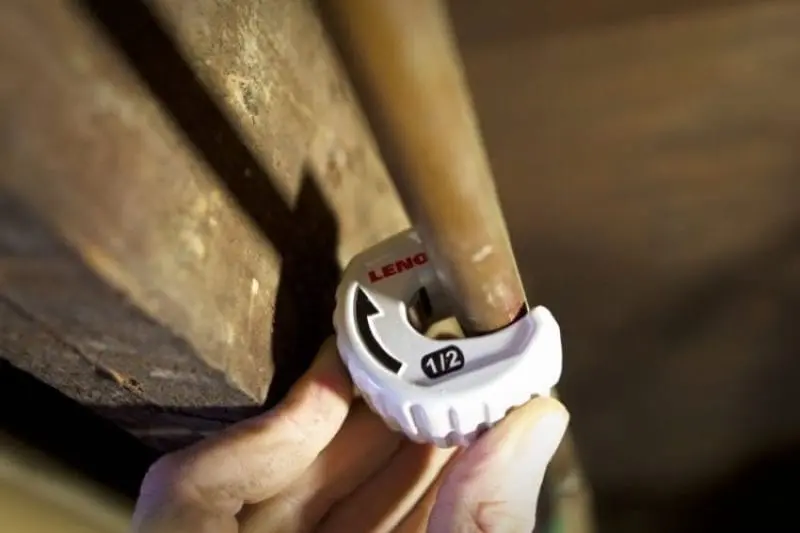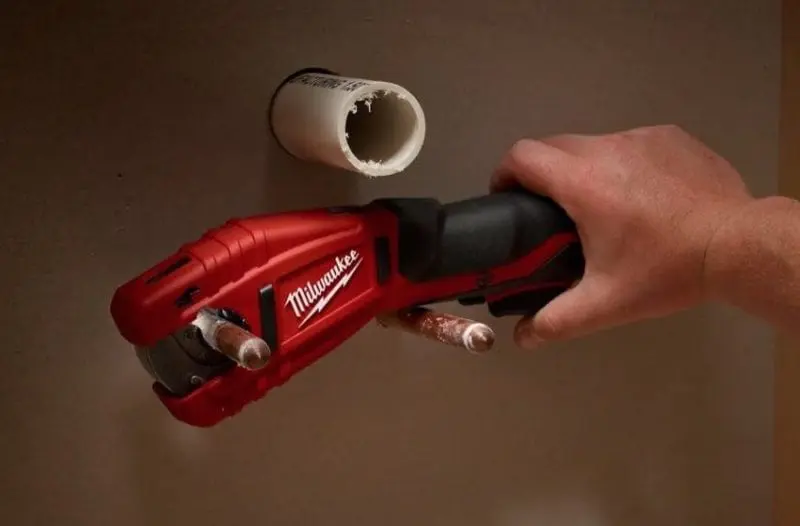We’ve been asked more than once how to cut copper pipe. From the easiest way to the way you want to do it if you have lots of copper piping to cut, methods vary. In the end, plumbers need to factor in budget, convenience, and the ergonomics of the job.
Table of contents
How to Cut Copper Pipe with a Copper Tubing Cutter
A copper tubing cutter (also called an autocut tubing cutter for some reason) is the best way we know how to work in close quarters. It ensures a straight, even cut and doesn’t deform the shape of the pipe. These cutters come in a variety of shapes and sizes. They range from truly small tools like the Milwaukee 1-inch copper pipe cutter to models with handles, like the Lenox tube cutter.
Copper tubing cutters come in all sorts of sizes to cover all kinds of pipe. The key sizes fall between 1/2-inch and 1-inch, however. You can get copper tubing cutters that can access both narrow, crowded areas as well as spaces where you may be able to utilize more leverage. Plan on having several styles and sizes just in case (you can also find kits).

Cutting copper pipe with these tools has served plumbers well for decades. They need replacing often, but some models have started making wheel replacements possible. The internal mechanisms, however, also tend to wear out over time. Many professional plumbers simply consider them disposable (eventually) and a cost of doing business.
The price of tube cutters varies from just a few dollars and goes up from there. Even the lower-priced tube cutters typically work well for simple weekend warrior work. The bottom line is that you want to match the quality of the tool with the expectation of the amount of work you have to do. It’s worth spending more if you intend to get a lot of life from the tool or if you’re a plumbing professional who’s looking for a top that will last for years to come.
Using a Hacksaw
If you use a hack saw, you probably cut pipe well outside of the installation area. Hacksaws leave a rather jagged edge that you need to clean up before you can work with it.

People use hacksaws to cut copper pipe because they typically have them lying around. If you have one, and you don’t need to access the pipe in place or underneath the sink, the tool works great. Just ream the pipe or use a copper pipe cleaner before you do any soldering.
Cutting Copper Pipe with an Oscillating Multi-tool
Some of the best oscillating multi-tools include vibration control that gives them lots of control. Since many of them also use battery power, this makes them a new go-to power tool for cutting copper pipe. Oscillating multi-tools cut best with finer-toothed metal blades. The idea is that you can get in close and even flush cut to a wall.

When you can’t get a copper tubing cutter or similar tool around a pipe, the oscillating multi-tool starts looking pretty handy. We keep one around for a variety of uses, but this one might be the most “life-saving”.
Battery-powered Copper Tubing Cutter
The Milwaukee M12 copper tubing cutter remains one of the most innovative products we’ve ever seen. This $199 kit lets you quickly and easily get in close and cut copper piping with zero effort. If you can hold the cordless copper tubing cutter in place, you can cut copper.

The only challenge with knowing how to cut copper pipe with a battery-powered tool is ensuring you have enough clearance. Provided you do, this tool makes cutting 3/8-inch to 1-inch copper tubing effortless. A 1.5Ah M12 battery delivers around 200 cuts while a 3Ah pack should net you well over 400.
Tools We Don’t Recommend for Cutting Copper Pipes
We can’t end this article without mentioning a few tools that we feel don’t fit well when making these cuts. Reciprocating saws top our list. While you can get a nice short metal blade for making these cuts, they rarely cut straight. Often leaving an angled cut, reciprocating saws really tend to make a mess of copper tubing. We find it far easier to control an oscillating multi-tool if you feel you must get in there with a powered saw.
It also should go without saying that we don’t recommend the use of any circular saws or miter saws for this type of cutting. While technically possible for prep work, other tools (like that Milwaukee M12 pipe cutting tool) do a much better job.



